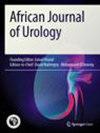Digital rectal exam in prostate cancer screening: a critical review of the ERSPC Rotterdam study
IF 0.4
Q4 UROLOGY & NEPHROLOGY
引用次数: 0
Abstract
The history of prostate cancer screening has evolved from relying on the Digital Rectal Exam to the introduction of PSA test. Initially, DRE was the cornerstone for diagnosing aggressive PCa, but the advent of PSA testing allowed for proactive detection. Distinctions between screening for the general population and early detection for individuals are vital. The French Onco-Urology Recommendations cite the European Randomized Study of Screening for Prostate Cancer (ERSPC), highlighting a 21% reduction in mortality using total PSA for screening, endorsing DRE in combination with PSA for early detection. However, a comprehensive analysis of the ERSPC study raises questions about DRE's role in screening. Studies indicate weak correlations between DRE and PCa diagnosis, especially with low PSA values. DRE's reproducibility is also a concern. As the ERSPC study progressed, DRE's significance diminished, and PSA became the primary screening tool. Other trials omitted DRE from their protocols, emphasizing PSA’s dominance. While some studies advocate for DRE in specific contexts, its overall utility in screening is questionable. It can be uncomfortable, has low sensitivity and specificity, and may lead to unnecessary biopsies. Controversies persist regarding its role in follow-up tests after the initial screening. In summary, the analysis of various publications suggests that DRE has limited value in subsequent PCa screening procedures, particularly in regions where screening has evolved beyond its initial use. PSA's dominance underscores the diminishing role of DRE in modern PCa screening practices.前列腺癌筛查中的数字直肠检查:ERSPC 鹿特丹研究的批判性回顾
前列腺癌筛查的历史从依靠数字直肠指检发展到引入 PSA 检测。最初,数字直肠指诊是诊断侵袭性前列腺癌的基石,但 PSA 检测的出现使前列腺癌的检测变得更为主动。对普通人群进行筛查与对个人进行早期检测之间的区别至关重要。法国肿瘤泌尿学建议》引用了欧洲前列腺癌筛查随机研究(ERSPC)的研究结果,强调使用总 PSA 进行筛查可将死亡率降低 21%,并赞同将 DRE 与 PSA 结合用于早期检测。然而,对 ERSPC 研究的综合分析对 DRE 在筛查中的作用提出了质疑。研究表明,DRE 与 PCa 诊断之间的相关性较弱,尤其是在 PSA 值较低的情况下。DRE 的可重复性也令人担忧。随着 ERSPC 研究的进展,DRE 的重要性逐渐减弱,而 PSA 成为了主要的筛查工具。其他试验在方案中省略了 DRE,强调 PSA 的主导地位。虽然一些研究提倡在特定情况下使用 DRE,但它在筛查中的整体效用值得怀疑。它可能会让人感觉不舒服,灵敏度和特异性较低,还可能导致不必要的活检。关于其在初次筛查后的后续检查中的作用,仍存在争议。总之,对各种出版物的分析表明,DRE 在后续 PCa 筛查程序中的价值有限,尤其是在筛查工作已经发展到超出其最初用途的地区。PSA 的主导地位凸显了 DRE 在现代 PCa 筛查实践中的作用越来越小。
本文章由计算机程序翻译,如有差异,请以英文原文为准。
求助全文
约1分钟内获得全文
求助全文

 求助内容:
求助内容: 应助结果提醒方式:
应助结果提醒方式:


